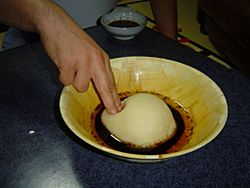Asida facts for kids

|
|
| Type | Pudding |
|---|---|
| Region or state | Middle East, North Africa, Horn of Africa |
| Main ingredients | wheat flour, butter or honey |
Asida (Arabic: عصيدة, romanized: ‘aṣīdah) is a popular dish from the Maghreb region of North Africa. It's like a thick dough or pudding. It is made by stirring wheat flour into boiling water. Sometimes, butter or honey is added to make it even tastier.
Asida is a very traditional food in many Arab countries. It is especially popular in Morocco, Libya, Algeria, Tunisia, Ethiopia, Eritrea, and the Middle East. People often eat it with their hands, without using forks or spoons.
This dish is often served during special religious holidays like Mawlid and Eid. It is also part of other traditional events. For example, it might be served when a baby is born, like during the ‘aqīqah ceremony. This ceremony involves cutting a newborn's hair seven days after birth. Asida is a simple but filling dish. It is often eaten for breakfast and is sometimes given to women who are about to have a baby.
Contents
What Does "Asida" Mean?
The word asida comes from the Arabic language. It comes from the root word asad, which means 'twist it'. This might refer to how the dough is stirred or shaped.
The History of Asida
Asida has a long history. One of the oldest recipes for asida was found in an Arabic cookbook from the 900s. This book was called Kitab al-Ṭabīḫ, or The Book of Dishes. It described asida as a thick pudding made with dates and clarified butter.
Another recipe for asida appeared in a Spanish-Muslim cookbook from the 1200s. In the 1200s and 1300s, people in the Rif mountains of Morocco used flour made from lightly grilled barley instead of wheat. A famous explorer named Leo Africanus (who lived from about 1465 to 1550) wrote about a recipe for asida that included argan seed oil. Experts believe that asida was a common food for the Bedouin people even before the time of Islam.
Different Ways to Enjoy Asida
Asida is made in different ways across various countries. Each region adds its own special touch to this traditional dish.
Moroccan Asida
In the old city of Fez, you can find vendors selling cold squares of semolina pudding. These are often sprinkled with sugar and cinnamon. Kids usually enjoy them after school.
Libyan Asida
In Libya, asida is often served with a sweet syrup. This syrup is usually made from dates or carob. Sometimes, honey is used instead. Melted butter is also poured around the asida itself, making it extra rich.
Tunisian Asida
The Tunisian version of asida can be served in two main ways. It might have a mix of honey and butter, which is more common earlier in the day. Or, it can be served with a hot chili pepper paste called harissa, which is more popular later in the day. In southern Tunisia, people also enjoy asida with carob syrup or date syrup.
Yemeni Asida
Aseedah or aseed (Arabic: عصيدة) is a very important dish in Yemen. It is often served for lunch, dinner, or both. It is made from wholemeal wheat, boiling water, and salt.
To make it, water is boiled, and then wheat flour is slowly added. The mixture is quickly stirred with a large wooden spoon to prevent lumps. This continues until the mixture becomes very thick. Traditionally, the cook lowers the pot to the floor and holds it with their feet while stirring very hard. Finally, the hot dough is shaped with oiled hands and placed in a wide, wooden bowl.
Sometimes, a dip is made in the middle of the Aseedah. A hot chili tomato paste or a fenugreek mixture called Helba (made with parsley and garlic) can be added there. Then, lamb or chicken stock is poured around the Aseedah. It is served hot. Aseedah can also be made with white wheat flour. Honey can be used instead of stock and chili/Helba. It is a simple meal, often smothered in beef, chicken, or lamb soup. It is usually served very hot and eaten with hands or spoons. Aseed is especially popular at lunchtime and during Ramadan.
Ethiopian Asida
In Ethiopia, a similar dish is called Genfo. It is served with Ethiopian ghee, which is a type of clarified butter called niter kibbeh. It can also be served with berbere (an Ethiopian spice mix), yogurt, or even milk. Genfo is a popular breakfast dish in Ethiopia.
See also
 In Spanish: Asida para niños
In Spanish: Asida para niños

